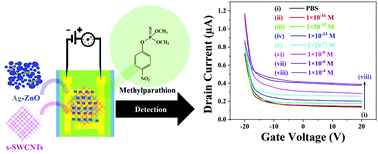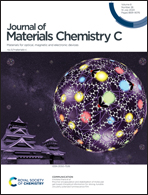Highly selective detection of an organophosphorus pesticide, methyl parathion, using Ag–ZnO–SWCNT based field-effect transistors†
Abstract
Semiconducting single-walled carbon nanotubes (s-SWCNTs) have been used in electrical transducers for environmental and health monitoring due to their quasi ballistic electron transport, efficient transconductance, high carrier mobility, good on/off ratio, excellent mechanical properties, etc. Herein, we have prepared a non-enzymatic pesticide sensor to selectively detect methyl parathion (MP, which is a restricted use pesticide according to the EPA) using a silver–zinc oxide (Ag–ZnO) composite decorated s-SWCNT based field-effect transistor (FET). The Ag–ZnO/s-SWCNT film is also characterized by using field-emission scanning electron microscopy (FE-SEM), energy-dispersive spectrometry (EDS), X-ray diffraction (XRD), Fourier-transform infrared (FT-IR), ultraviolet-visible-near infrared (UV-vis-NIR), Raman and photoluminescence (PL) spectroscopies. The electrical response of the Ag–ZnO/s-SWCNT–FET was measured under ambient conditions in the presence and absence of MP. The hydrolysis of MP took place due to the potent catalytic activity of Ag–ZnO, which led to changes in transistor conductance. Based on this, detection of the different concentrations of MP was demonstrated by using Ag–ZnO/s-SWCNT–FET. The Ag–ZnO/s-SWCNT–FET device showed a linear response from 1 × 10−16 M to 1 × 10−4 M MP with a limit of detection (LOD) of 0.27 × 10−16 M in 0.1 M phosphate buffer solution (PBS). In addition, Ag–ZnO/s-SWCNT–FET exhibited acceptable reproducibility and repeatability when employed for MP detection. Moreover, the proposed FET sensor was highly stable under ambient conditions. Finally, the accurate detection of spiked MP is demonstrated in soil and rice samples with good recovery.



 Please wait while we load your content...
Please wait while we load your content...